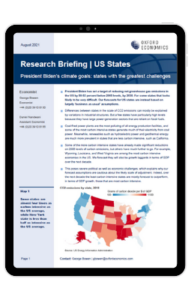US | President Biden’s climate goals: states with the greatest challenges

President Biden has set a target of reducing net greenhouse gas emissions in the US by 50-52 percent below 2005 levels, by 2030. For some states that looks likely to be very difficult. Our forecasts for US states are instead based on largely ‘business as usual’ assumptions.
What you will learn:
- Differences between states in the scale of CO2 emissions can mostly be explained by variations in industrial structures. But a few states have particularly high levels because they have large power-generation sectors that are reliant on fossil fuels.
- Coal-fired power plants are the most polluting of all energy production facilities, and some of the most carbon intensive states generate much of their electricity from coal power.
- Some of the more carbon intensive states have already made significant reductions on 2005 levels of carbon emissions, but others have much further to go.
Tags:
Related Services

Post
UK: Supply constraints are probably less prominent in the south
The extent to which UK employers can respond to likely 2024 interest rate cuts with increased output, rather than rises in prices and wages, will partly reflect the extent of spare capacity. This will inevitably vary by region. Evidence on this is imperfect, but in terms of capital assets (including intangibles) and labour availability, southern regions appear to be in a stronger position than those in the UK's traditional industrial heartland.
Find Out More
Post
Global Private equity real estate fund maturities spur asset sales
We expect the significant increases in fund maturities, spurred by capital raised over the past decade, to exert upward pressure on the rate of asset disposals as the funds approach the end of their lifecycles.
Find Out More